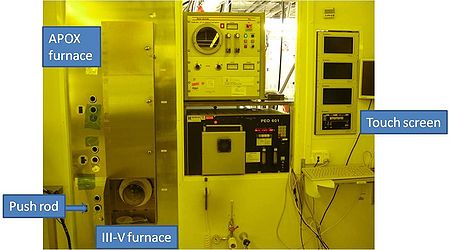Specific Process Knowledge/Thermal Process/D4 III-V Oven: Difference between revisions
No edit summary |
|||
| Line 2: | Line 2: | ||
''This page is written by DTU Nanolab internal'' | ''This page is written by DTU Nanolab internal'' | ||
===<span style="color:Red">EXPIRED | ===<span style="color:Red">EXPIRED. The D4 III-V Oven has been removed from the cleanroom August 2019. At the moment there is not replacement for it.</span>=== | ||
Latest revision as of 13:00, 17 April 2023
Feedback to this page: click here
This page is written by DTU Nanolab internal
EXPIRED. The D4 III-V Oven has been removed from the cleanroom August 2019. At the moment there is not replacement for it.
III-V Oven (D4)

The III-V Oven (D4) is used for wet thermal oxidation of III-V devices, for instance for lateral oxidation of thin AlGaAs layers to defined apertures in light-limiting diodes.
The furnace is an old Tempress horizontal furnace. The quartz boat is loaded manually into the furnace by use of a push rod. The furnace is cooled down to room temperature when it is not being used.
Before use, devices have to be cleaned. A short BHF dip can be used to remove any native oxide which can be difficult to penetrate by a wet thermal oxidation.
Please check the cross contamination information in LabManager before you use the furnace.
The user manual and contact information can be found in LabManager:
Process knowledge
| Purpose |
| |
|---|---|---|
| Performance | Lateral oxidation rate |
|
| Process parameter range | Process temperature |
|
| Process pressure |
| |
| Gasses on the system |
| |
| Substrates | Batch size |
|
| Substrate materials allowed |
|
